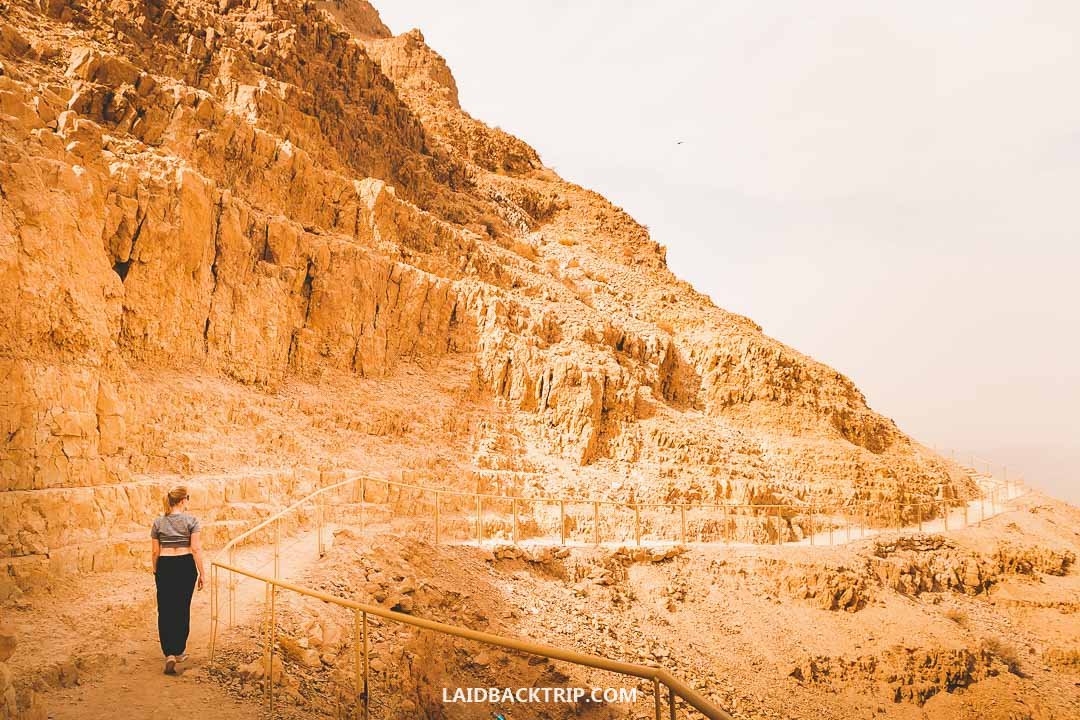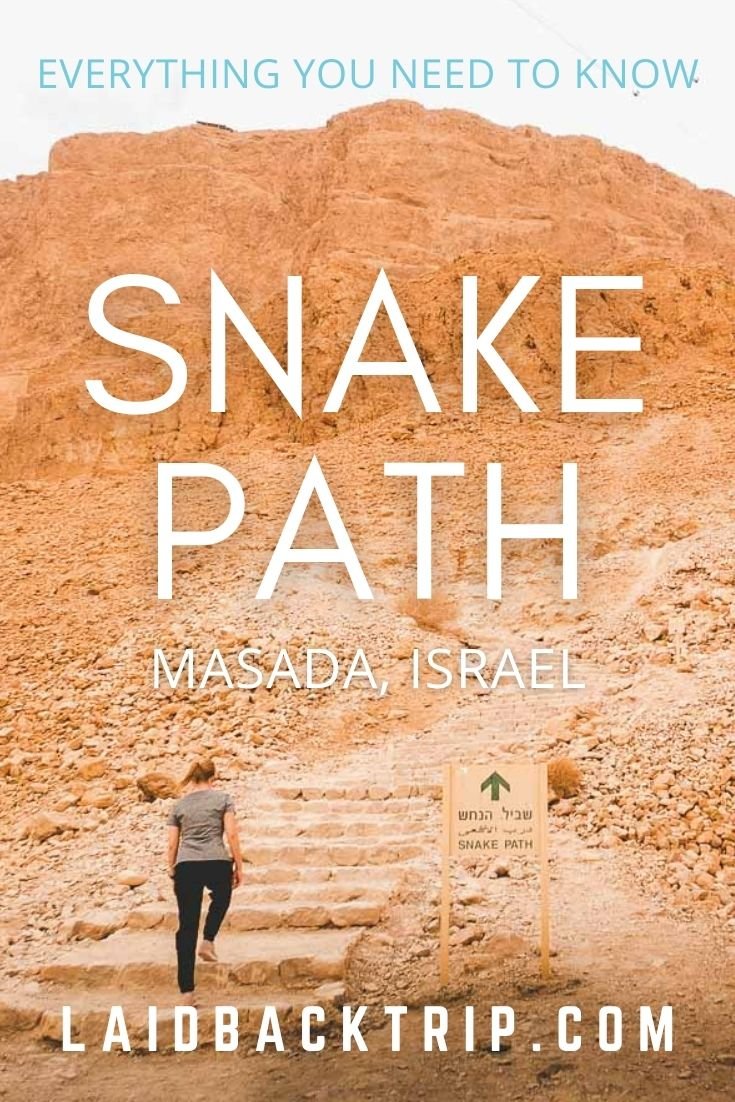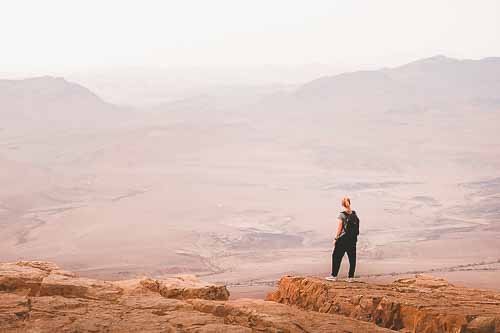Hiking the Snake Path Trail to Masada in Israel
Are you planning to hike the Snake Path to Masada in Israel? Read our hiking guide that includes tips on what to expect, elevation, length, difficulty, where to find the trailhead, and how to get there.
We believe that the in-and-out Snake Path trail is the best way to reach the Masada, and that's why we have decided to write a separate blog post that focuses only on this trail.
There has been said and written so much about Masada Fortress in Israel (sometimes spelled Metsada) that we don't need to come up with any elaborate openings.
But if you are still not sure what Masada is and you should include it in your Israel itinerary, then we'll just briefly introduce it to you.
Masada is an ancient fortress built by Herod the Great standing on top of the mesa in the Judaean Desert near the Dead Sea that became famous due to the Roman siege and the ultimate sacrifice of the Jewish rebels who hid there.
It's also a UNESCO Heritage Site that offers sweeping views on top of the fascinating history and ancient structures.
And as mentioned above, there isn't probably a better way to get to Masada than hiking the Snake Path, which is a zig-zag trail that will make you feel that you really deserved the Masada experience.
Moreover, as the trail ends in this special place, Snake Path is often considered one of the best hikes in Israel.
So, here's everything you need to know about hiking the Snake Path to Masada.
Length and Elevation
Snake Path can be tackled relatively quickly with a distance of 2 kilometers (one way) and an elevation gain of 350 meters.
So how long does it take hiking the Snake Path up to Masada?
It usually takes about 40 to 60 minutes to walk from the bottom of the valley all the way to the top, but several factors can affect the final time.
If you're fit and don't plan on doing short photo breaks along the trail, then you can get to Masada in about 30 minutes.
We made several stops to enjoy views and take some lovely pictures, so we reached Masada in 40 minutes.
Also, the upper part of the trail was a bit narrower, so it was harder to pass the student groups on the way down.
And if we were hiking in the summer, we would probably take things more slowly so we would arrive at the top with some energy left in the tank.
To be honest, if you are out of shape or just not used to a physical activity lately, but you want to outdo yourself and skip the cable car ride, allow yourself anything from 60 to 90 minutes for the climb.
This way, you won't have to hurry and enjoy the hike. Make sure you have enough water.
Difficulty
We would say that the Snake Path is a moderately challenging hike, and any rather fit hiker should be able to get to the top without too much hassle.
We would even incline to rate the trail as easy to moderate, but the temperatures can indeed make it a bit harder plus, we must confess that we daily jog, so we are used to cardio activities.
Simply put, it's one of those short and (not that) intense hikes that you either love or hate.
The trail was originally built during the construction of the palace to allow access for working animals and people.
Therefore, Snake Path is not as hard as you can often read, as the incline is simply not that steep.
However, you need to consider one more critical factor before you go - the weather in the summer.
One of the most important things to know about Israel is that the extremely hot summers in this region can make your travels not very enjoyable.
There's no shade along the trail, so the relentless sun in the summer will definitely make the hike more challenging, and there is one fact we cannot hide, it is two kilometers uphill.
Trailhead
You'll find the Snake Path trailhead on the eastern side of Masada.
As Masada has two entrances (western and eastern), this is something you should remember before setting your destination into your GPS navigation.
The trailhead starts only a few meters from the Visitors Center, which we recommend you visit first
If you leave your car at the lower parking lot, you can access the Snake Path from there as well. This information is helpful when you do the sunrise hike, as the Visitors Center will be closed.
How to Get
Masada is a top tourist attraction in Israel, and it couldn't be easier to get there independently or with a tour.
Car
We chose to get around Israel by car, so we arrived at Masada this way.
Getting to Masada by car is very easy, but you can also get there by public transport.
Driving in Israel was quite straightforward as well, and having a car while there allowed us to see more in less time.
When traveling through the West Bank, make sure your rental car allows it, and you have valid car insurance. Otherwise, take a detour via Beer Sheva and Arad.
If you're considering this option, then here you can search for the best deals on rental cars in Israel.
Bus
Unlike the Roman Path in the West Entrance, the Snake Path is serviced by public transport.
From Jerusalem Central Bus Station, take a bus 486 (Egged) to Masada Center. It really can't be simpler than that.
If you're arriving from Tel Aviv, you need to get to Jerusalem first and then follow the instructions above.
Tour
Lastly, taking a Masada tour is also a possibility.
For those who don't want to give up the hiking part, make sure to book a sunrise tour as the regular tours usually arrive at Masada later and include cable car rides instead of walking.
Here, you can reserve either Masada Sunrise Tour from Jerusalem or Masada Sunrise Tour from Tel Aviv.
Parking
Starting our day early in the morning in Nazareth, we traveled along Highway 6 all the way to Ein Bokek and eventually to Masada.
As we decided to hike Snake Path, we had to leave our car at the free parking lot on Masada's eastern side.
We got lucky and found an empty spot in the upper parking lot, but in the end, it didn't matter that much.
After spending some time in the museum and watching the movie, we headed out to the trailhead.
Why Hike the Snake Path?
As you probably know already, we love hiking and staying active while traveling. Therefore, getting to the top via the Snake Path was an obvious choice.
The lack of exercise is one of the few things we don't like about traveling, so we grab every opportunity to change that.
Getting to Masada on foot is beneficial not only for your health but also for your wallet.
Therefore, walking the Snake Path is a great alternative for travelers who want to visit Israel on a budget.
Lastly, it's easier to reach the eastern entrance from the Dead Sea area, and you can even get there by bus.
If you're short on time, you'll have more time for either hiking in Ein Gedi or swimming in the Dead Sea on the same day.
Hiking the Snake Path
Although we planned to start the hike earlier, several traffic jams on the highway delayed us for a few hours.
This could've been a far more significant issue in the summer, but the mid-autumn temperatures proved to be pretty okay.
Once we left the Visitors Center, we found the trailhead, snapped a quick photo with the Snake Path trailhead sign and started to make our way up to the fortress.
The first few hundred meters were mostly flat, but once we crossed the dry creek, the trail turned right, and we finally started to climb up.
Unfortunately, we started late and didn't get much of the Dead Sea views on the way up because of the haze, but we knew it was there, so we tried to keep our hope up.
When we were descending to the Dead Sea on Highway 31, we stopped on a couple of viewpoints and barely could see the salt lake.
By the time we arrived at Masada, the haze had gotten so strong that it covered pretty much the entire horizon.
The trail surface is not very varied. It's either steps or loose gravel with rocks.
And if you don't like steps, then you'll have a hard time enjoying the trail as it's said that there are roughly 700 of them.
By the way, as you start at almost 400 meters below sea level, you can take advantage of the abundance of oxygen in the air.
Similar to when we drove on the Dead Sea Highway in Jordan last year, Lucie couldn't help herself and made fun of me all the time that I must feel here like at home.
Unlike some high-altitude hikes we've done on our previous travels, such as Tilicho Lake in Nepal or Rainbow Mountain in Peru, you can really feel that you can take full breaths when doing the Snake Path.
At last, we arrived at the East Gate, and once we walked through it, the entire Masada opened up in front of us.
As there is plenty to see and do in Masada, don't forget to read our in-depth Masada guide, which features plenty of additional practical information.
Later on, we returned to the East Gate and started descending to the parking lot, together with a few dozens of school kids who usually enter the Masada via the West Gate and leave through the East Gate.
The advantage of in-and-out trails is that the weather can shift after a few hours, and that's what happened today.
The haze dispersed a bit, and we could finally enjoy some awesome views of the Dead Sea from Masada and the Snake Path.
We mentioned above that it took us about 40 minutes to get to the fortress, and I believe that we walked back to the parking lot in less than 25 minutes.
Can You Hike to Masada Independently?
If you're not an experienced hiker wondering whether you can hike to Masada without a guide, then note that the trail is well-maintained, well-marked, and heavily trafficked.
Therefore, it's doable even on your own, and the chances that you'll get lost are pretty slim.
Opening Hours
Yes, even the Snake Path trail has opening hours. Snake Path opens an hour before sunrise and closes an hour after sunset.
In summer, Masada is open from 8 AM to 5 PM from Sunday to Saturday (closes at 4 PM on Friday).
The winter opening are slightly different, so Masada is open from 8 AM to 4 PM from Sunday to Saturday (and closes at 3 PM on Friday).
Even more important thing to know about this hike is that Snake Path can be closed due to extreme heat.
Usually at either 8 AM for the ascent and 9 AM for the descent or 9 AM for the ascent and 10 AM for the descent, depending on the current temperature.
Entrance Fee
One of the main reasons that we chose the hike over the cable car was that there is no entry fee to Snake Path.
We love hiking, but being able to save some money on the road is also great.
Sure, you still need to purchase the Masada ticket for 31 NIS ($10) per adult, but you can get the Israel Pass to lower the ticket price.
When to Go
As mentioned above, the summer temperatures in Masada and the Dead Sea area, in general, can be brutal.
That's also one of the reasons why sunrise or sunset hikes to Masada are so popular.
Not only to see the rising sun over the Dead Sea or setting sun over the Judaean Desert but also to avoid the deadly heat.
If you're wondering whether it's better to do the sunrise or sunset hike, we would probably choose the former.
We would argue that you can see Masada and get back before it gets extremely hot and avoid the noon heat by visiting the museum or hiding in your air-conditioned room in Ein Bokek.
However, we also believe that it's better to visit the museum first, so we'll really leave the decision up to you.
By the way, if you're wondering when is the best time to visit Israel, then we would only say that you should avoid the summer, especially if you want to also see the Negev Desert or Sea of Galilee.
We hiked the Snake Path in November and started around noon, and the temperatures were acceptable.
Is Snake Path Trail Safe?
If you follow the basic recommendations, Snake Path Trail is safe.
Keep in mind that the Judaean Desert receives extremely hot summers, so always stay hydrated throughout the entire day.
Here you will find more tips on staying safe in Israel.
Travel Insurance
We never leave home without travel insurance that was designed to cover our expenses if something goes wrong during the trip.
Travel insurance protects against theft, flight delays, injury, illness, cancellations, and much more.
World Nomads provides travel insurance for travelers to cover their trip essentials, including sports and adventure activities.
SafetyWing is affordable travel insurance for backpackers, long-term travelers, and digital nomads.
Travel smarter and safer!
What to Pack
You'll need only a few essential things for the Snake Path hike, so try to pack light.
Firstly, make sure you bring with you a water bottle. While you don't need to overdo it this time, as there are a few drinking water stations up at Masada, it's still better to bring enough water for the hike.
In summer, make sure you bring something to cover your head. Whether it's a cap, hat or scarf, it will help you deal with the sun.
Due to the low elevation, it's often said that you don't need to use that much sunscreen, but we brought ours anyway.
We believe, that as there is no shade on the trail and the Masada complex is open as well, a strong sunscreen is a must-have.
The trail is well-maintained, but that doesn't mean that you should underestimate the footwear.
Make sure you have some closed-toe shoes as the path is rocky and has lots of steps. Regular runners should be more than enough.
We saw a few hikers using trekking poles, but while they might be useful for some on the slippery surface or steps, we don't think that they're an essential item for this hike.
You'll also need a small and comfortable daypack that will contain your water bottle and the rest of the things you'll bring with you.
If you're doing the sunrise or sunrise hike, you can also consider bringing a headlamp, though there's usually enough light that you can see the trail without it.
In winter, it can be windy and bit cold up there, so have a windbreaker in your daypack.
Is It Worth Hiking the Snake Path?
If you're an avid hiker, then we would definitely say that the Snake Path is worth the effort.
If you're someone who doesn't hike frequently, you can indeed make your life easier and take the cable car instead.
But we believe that it never hurts (well, maybe a little bit) to stretch your legs and get some exercise even when on vacation.
And the feeling when you walk through the gate after tackling the climb is priceless.
Travel Resources
Here you can find links to all the travel resources we use and which you might find helpful when planning your next holiday.
Accommodation: When looking for accommodation, we usually search hotels via Booking.com or Hostelworld.
Tours: Although we love to travel independently, some places are better to visit with a guided tour.
We prefer GetYourGuide for its easy-to-use interface and solid reputation. Another great alternative is Viator.
Rental Cars: When going on a road trip, we always use Rentalcars.com, a reliable site for booking a rental car in advance.
Flight Tickets: When looking for flight tickets, you can search Skyscanner to find the best price.
Travel Insurance: World Nomads and SafetyWing cover against risks of travel.










